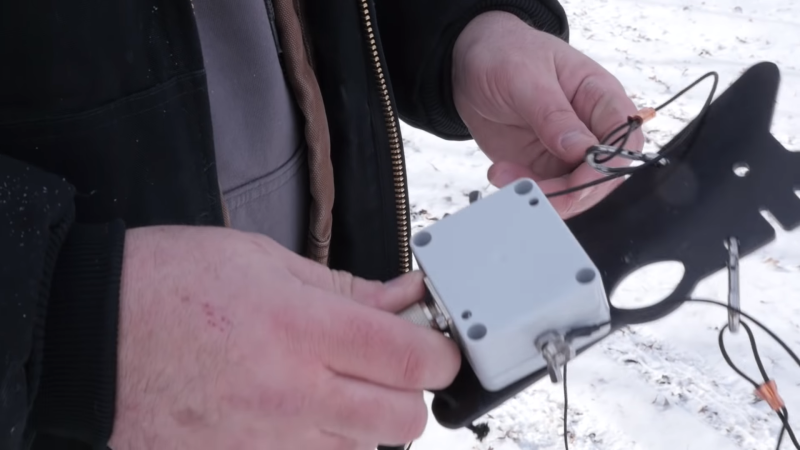Ham radio isn’t just one hobby. It is a bunch of hobbies ranging from chatting to building things, bouncing signals off the moon, and lots of things in between. Some of these specialties, such as supporting disaster relief or putting odd locations “on the air”, require portable operation. To encourage disaster readiness, hams participate in Field Days which is a type of contest that encourages simulated emergency conditions. So how do you erect an antenna when you just have a few hours to set up a temporary station? [KB9VBR] shows how he and his friend used a Chameleon Emcomm III portable HF antenna for Winter Field Day. You can see the video review, below.
Unlike some portable antennas, this one is almost 100 feet of wire (73 feet of radiator and a 25 foot counterpoise). The entire affair is meant to be put up and taken down repeatedly.
Unfortunately, the guys didn’t like the setup — it is always going to be tough to manage that much wire. They did like that the Teflon-coated wire didn’t hang up in the trees as easily as some wire. Overall, they still gave it an 8 to 9 out of 10. It seemed to work well, at least in two directions. The way they set it up, they were not getting out to the east and west.
According to EMCOMM, the antenna takes 15 minutes to erect, although that might not take into account the extremely cold Wisconsin weather. The antenna is rated at 100 watts for all HF ham bands and weighs in at 1.5 pounds. Should be fairly easy to stuff in a backpack for hiking.
We expect most radios will want a tuner for this antenna to minimize VSWR mismatch. We’d love to see a network analyzer plot of the antenna in some common configurations.
















Interesting. Reminded me of a time I helped erect an HF antenna for a Civil Air Patrol training exercise. I know little about radio operation, but I remember the radio guy mentioning that HF often radiated mostly in just one axis (north/south, east/west), and that sometimes distant transmissions were much easier to receive than local ones.
True. Dipole antennas radiate best on the broadside. So the ends of the antenna suck for the receive/transmit side of things. Also, he is right about the local vs far station reception. Unless the local station is configured in an NVIS (near vertical incident skywave) there is a significant deadzone between the skywave and ground wave propagation. Once the signal hits the ionosphere, then coverage is a little more general, but since your take off angle on antennas is fairly shallow, it takes some distance to be covered before you see ionosphere interaction.
While I am not sure of the actual configuration of the antenna I assume that it radiates its strongest bi-directionally and perpendicular to the radiating wire. Thus is he doesn’t have propagation East and West, the antenna wire must be laid out North to South. From Russ Copping, AD5W Covington, LA.
Field Day is during the best time of the year, near summer solstice. I didn’t know that they also do one mid winter and a real disaster exercise at that. No picnic no barbecue. It got scary with the natural gas piping plant fire in Michigan.
Slingshot and weighted line and heaver lines to follow and only pull lines not wires with ends and inductors to catch.
Oh great, another expensive longwire antenna that promises the world and military grade this and that.
Is it complete with the cheapest of cheap voltage 1:9 unun with zero common mode rejection like most of it’s kin?
Sure, they have their use, but with all the downsides and that price, it’s really not worth it.
If you want one, build your own, and make sure to add a choke so your radio doesn’t become a part of the antenna.
agreed.. 150 USD for a piece of wire, a plastic box and and a useless toroid (as the impedance of an end-fed antenna depends on the frequency, and one transformation ratio cannot fit all )
An MCU controled impedance transformer (or a manual one, but I’m a lazzy guy), wrongly called “ATU” by some, and a simple homemade Zep would to the same job with a better efficiency imho.
f6itu
As a SOTA activator I can say that this antenna is too heavy for backpacking in. A QRP Guys endfed with 9:1 unun is lighter especially using #26 Teflon coated wire. But the power handling capability is much less than the Chameleon. So walk in or drive in use for FD is a good use. I prefer a #22 speaker cable dipole for backpacking to a peak though I still carry the QRP Guys endfed just in case. de AI6XG
Excellent piece of equipment. …
Shut you down as soon as you bad mouthed Bao Feng…..
Forger about network analyzer and return loss plot. Wire antennas are reactive and need matching networks to function properly.
Thanks for the video. It made me smile being from the Madison, WI area. Living in the Yucatan, MX now seeing winter operation brought back memories. A bit surprised that you had so little luck off the ends on contacts. I know the EFHW is pretty bi-directional, but ones I’ve used will do fairly OK off the ends, Nice job, and loved the addition of the “Fantasy Factory”, a personal favorite, to the video… 73’s Paul NA9M
Excellent information. ..
I’m Joe KD9CJX. I’m the guy in the video. Your assumption that we didnt like the video is wrong. We love it! It’s in my go bag for HF portable.
73